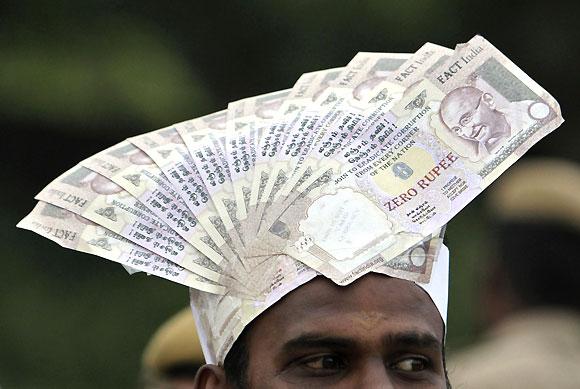 | « Back to article | Print this article |
Rupee slide: Mixed bag for India Inc
At 58.03, the Indian Rupee touched an all-time low in intra-day deals today, depreciating nearly 8% against the US Dollar (USD) in last the one-and-half months. The slide comes on the back of fears of the US Federal Reserve, or the US Fed, winding down its $85-billion-a-month bond buying programme as their economy is showing signs of revival.
Though the jury is still out on when and whether the US Fed will resort to such a move given the latest US jobs data, the global markets off-late have been rattled at the prospects.
For instance, Nikkei has slipped 15% from a five-and-a-half year high it reached on May 23, as investors were spooked by worries over slowing growth in China and uncertainty over the US Fed's course of action. Investors have also been disappointed with Abe's growth strategy last week to revive the world's third-largest economy.
“Currency hitting lows against the dollar is a broad Asia story and not an INR-specific story. The fear of winding down of the third round of quantitative easing (QE3) by the US Federal Reserve is causing outflows from most emerging markets (EMs). Most Asian FX, including the INR, has been under-performing. Countries – particularly like India and Indonesia – that have a high current account deficit (CAD) are at risk in this environment,” points out Sonal Varma, economist, Nomura.
“We are not surprised that the INR has again been among the worst hit of BRIC currencies in this round of volatility. In our view, it will continue to trade weak till the Reserve Bank of India (RBI) is able to recoup the $60 billion of FX (including forwards) sold since 2008. Keeping rates high will only defer recovery, deter FII equity inflows and delay re-accumulation of FX reserves,” notes Indranil Sen Gupta, India Economist, DSP Merrill Lynch (India) in a report dated 09 June, 2013.
Click on NEXT for more...
Rupee slide: Mixed bag for India Inc
Impact
In the Indian context, the slide in the rupee has been a boon for the stocks of export-oriented sectors such as software services and pharmaceuticals companies that have outperformed the market, as a stronger dollar boosts the sales of these firms in rupee terms. The IT sector earns around $100 billion a year from export of software and services.
Between April 30 - June 7, 2013, the BSE IT index has surged 8%, in-line with the rise in the rupee; while FMCG and healthcare indices have moved up 2.4 per cent and 2.3 per cent, respectively. The movement also factors in the reaction of the March 2013 quarter results and the road ahead.
On the other hand, there will be limited gains for companies in the engineering goods, gems and jewellery sectors, while oil and gas, power, metal and capital goods sectors could be adversely impacted. Stocks from these spaces are down between 3-4 per cent during the above-mentioned period.
Adds Varma: “One cannot paint every company with the same brush. There will be differentiation in how the rupee slide impacts companies. The rupee touching a record low could be beneficial for exporters to the extent they have borrowings in forex. However, if there is un-hedged borrowing, the impact could be negative due to currency depreciation. Importers could see some negative impact of this adverse movement in the INR.”
Among individual stocks, TCS, Infosys and MphasiS from the IT pack have surged more than 10% each, while Lupin, Dr Reddy’s Laboratories and Sun Pharmaceutical Industries from pharma sector have gained between 6-9 per cent.
The state-owned oil marketing companies - Indian Oil Corporation, Bharat Petroleum Corporation and Hindustan Petroleum Corporation have lost 10% each due to multiple factors including the rupee depreciation, which turned the import of oil costlier.
Click on NEXT for more...
Rupee slide: Mixed bag for India Inc
Outlook
Analysts say that the rupee trajectory, going ahead, will be a function of flows. If the money continues to go out of the country, then there could be a problem. Even if the gold import comes down, financing the deficit will still be a challenge.
“The major reason that we foresee behind rupee depreciation is the rise in US treasury yield, which is leading to the unwinding of carry trade in US dollar/Indian rupee,” said Abhishek Goenka, Founder & CEO, India Forex Advisors.
According to Nikhil Vora, MD and head of research at IDFC Securities: “The rupee weakness is a major concern for the markets and India Inc has a fair bit of forex loans. The new level/base for the INR has moved away from 52 – 53 closer to 55 – 57 levels. I don’t see it moving above 60 levels in the next six months.”
On a positive note, however, Jayant Manglik, president – retail distribution, Religare Securities says that the only silver lining for India so far is that foreign institutional investors continue to pour money and the rupee’s decline has not impacted their appetite for Indian stocks. Thus, inflows continue to fund the current account deficit to an extent, he adds.



